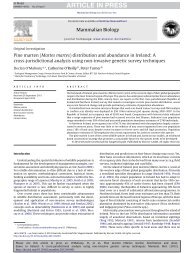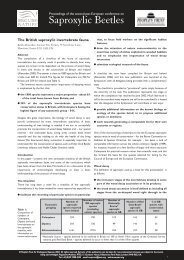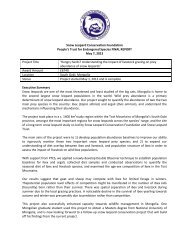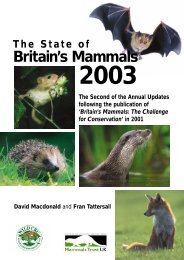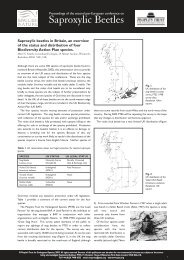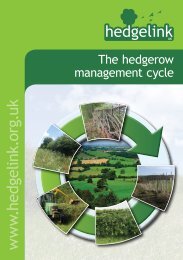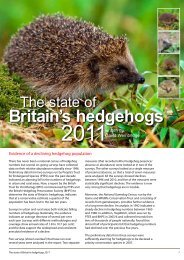final report - People's Trust for Endangered Species
final report - People's Trust for Endangered Species
final report - People's Trust for Endangered Species
Create successful ePaper yourself
Turn your PDF publications into a flip-book with our unique Google optimized e-Paper software.
Factors that are influencing the decline of the species.<br />
The main threats to the species are well documented and include habitat degradation and loss,<br />
predation, population isolation, persecution, changes in water levels, and pollution.<br />
Changes in land-use and riparian management have resulted in increased vulnerability to predation<br />
by mink, which is thought to have accelerated the population decline (Strachan & Moorhouse 2006).<br />
Habitat degradation and loss<br />
Many Watercourses in the UK have been engineered <strong>for</strong> the carriage and the containment of water<br />
using hard bank protection and engineering, and during this process have lost their natural features<br />
and habitats. These modifications channel the water at an increased rate and can contribute to<br />
erosion, flooding, and effecting channel downstream.<br />
Intensification of farming has also attributed to bankside changes with margins being overgrazed<br />
leading to a reduction in bankside and marginal vegetation which is a food source and predation<br />
cover <strong>for</strong> the water vole.<br />
Predation<br />
Un<strong>for</strong>tunately <strong>for</strong> the water vole they are prey to many predators which include; brown rats, owls,<br />
heron, otters, stoat, weasel, fox, kestrel, domestic cats and the American mink. To escape from<br />
predators, water voles take cover in dense vegetation or dive into the water and escape to their<br />
burrows. This strategy is ineffective against the mink because they swim well, hunt efficiently and<br />
the females can enter water vole burrows. (Strachan and Moorhouse 2006).<br />
The presence of mink and absence of high quality habitat are inimical to water voles. In the vast<br />
majority of cases, populations can only exist if high quality habitat is present and mink are absent<br />
(Strachan and Moorhouse 2006).<br />
Isolation<br />
Isolated populations are vulnerable to habitat changes and predation. Within urban situations vole<br />
colonies may be small, separated by engineered watercourses. Narrow strips of fragmented habitat<br />
can isolate extant water vole populations, making them more susceptible to stochastic variables<br />
such as drought, floods, disease and American mink predation (Barreto et al 1998a).<br />
Persecution<br />
The persecution of water voles is often indirect or unintentional. Water voles can be confused with<br />
brown rats which have led to the accidental destruction of water vole colonies, particularly in urban<br />
areas when control methods using rodenticides are used carelessly.<br />
Changes in water levels<br />
Water vole habitat can be affected by fluctuations in water levels especially when floods or droughts<br />
occur. Excessive fluctuations can cause burrows to flood affecting access to food and cover (Mullard<br />
2007). Reduction in water levels can also be unfavourable to the water vole; leaving burrows<br />
exposed making voles more vulnerable to predators. (Strachan 1998). Changes in land use, land<br />
drainage and flood control may exacerbate the process although canals are rarely affected by these<br />
fluctuations.<br />
Pollution<br />
Another factor thought to have caused the decline of the Water Vole population is pollution.<br />
Contaminants include organochlorine insecticides, heavy metals and organic pollutants maybe<br />
harmful although the specific effects on water voles have not been researched in detail.





